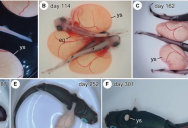Advancements In Artificial Womb Technology Successfully Gestate Baby Sharks For 355 Days

When animals, including humans, are born prematurely they can be at serious risk of having a variety of different types of issues.
Some of the issues are related to the fact that they were not able to develop normally while in the womb.
Others are because life outside of the mother can be very harsh and dangerous.
Scientists in Japan have developed an artificial womb that is designed specifically to help baby sharks incubate until they reach a state of development where they can safely emerge.
In previous versions of the technology, scientists have only been able to keep a shark alive in an artificial womb for 160 days.
The newly designed artificial shark womb was able to help several of the embryos grow for 355 days until they reached their normal birthing size.

The artificial womb works by keeping the sharks in an artificial uterine fluid where they can grow and develop. This fluid has to change over the course of their development in order to ensure they can survive outside when the time comes.
To do this, scientists have had the sharks start in a 100% artificial uterine fluid solution, and slowly taper it off over the course of months.
The womb would introduce seawater into the solution slowly, bringing their environment from 100% uterine fluid all the way down to just 6.3% by the end.
At that point, the sharks can be ‘born’ and swim in the aquarium water normally.
The lead study author and researcher at Okinawa Churashima Foundation, Taketeru Tomita, said of the development:
“In our aquarium, as in the outside world for conservation, we cannot select the species we receive. The reproductive systems of sharks have great diversity, and I think our system can only apply to about half of viviparous sharks. We would like to develop more universal systems.”
Having artificial wombs that will work for a variety of different types of sharks will help to save the lives of premature sharks, especially those that are endangered.
While this new technology was successful, not all of the sharks involved survived.
In fact, only three of the initial 33 sharks lived through the process, which indicates that additional improvements do need to be made.

The three that did survive, however, are thriving and living just like any other baby shark. Once they emerged from the artificial womb, they were fed minced mackerel, and shrimp, and behaved just as expected.
Advancement of technologies for artificial wombs is exciting for animals, and someday, hopefully, for humans.
Thought that was fascinating? Here’s another story you might like: Why You’ll Never See A Great White Shark In An Aquarium

Sign up to get our BEST stories of the week straight to your inbox.




